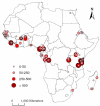Using the entomological inoculation rate to assess the impact of vector control on malaria parasite transmission and elimination
- PMID: 20459850
- PMCID: PMC2890672
- DOI: 10.1186/1475-2875-9-122
Using the entomological inoculation rate to assess the impact of vector control on malaria parasite transmission and elimination
Abstract
Background: Prior studies have shown that annual entomological inoculation rates (EIRs) must be reduced to less than one to substantially reduce the prevalence of malaria infection. In this study, EIR values were used to quantify the impact of insecticide-treated bed nets (ITNs), indoor residual spraying (IRS), and source reduction (SR) on malaria transmission. The analysis of EIR was extended through determining whether available vector control tools can ultimately eradicate malaria.
Method: The analysis is based primarily on a review of all controlled studies that used ITN, IRS, and/or SR and reported their effects on the EIR. To compare EIRs between studies, the percent difference in EIR between the intervention and control groups was calculated.
Results: Eight vector control intervention studies that measured EIR were found: four ITN studies, one IRS study, one SR study, and two studies with separate ITN and IRS intervention groups. In both the Tanzania study and the Solomon Islands study, one community received ITNs and one received IRS. In the second year of the Tanzania study, EIR was 90% lower in the ITN community and 93% lower in the IRS community, relative to the community without intervention; the ITN and IRS effects were not significantly different. In contrast, in the Solomon Islands study, EIR was 94% lower in the ITN community and 56% lower in the IRS community. The one SR study, in Dar es Salaam, reported a lower EIR reduction (47%) than the ITN and IRS studies. All of these vector control interventions reduced EIR, but none reduced it to zero.
Conclusion: These studies indicate that current vector control methods alone cannot ultimately eradicate malaria because no intervention sustained an annual EIR less than one. While researchers develop new tools, integrated vector management may make the greatest impact on malaria transmission. There are many gaps in the entomological malaria literature and recommendations for future research are provided.
Figures





References
-
- Implementation of indoor residual spraying of insecticides for malaria control in the WHO African Region report. http://www.afro.who.int/vbc/reports/report_on_the_implementation_of_irs_...
-
- Warrell DA, Gilles HM. Essential malariology. Fourth. New York: Arnold; 2002.
Publication types
MeSH terms
LinkOut - more resources
Full Text Sources
Medical
Research Materials

